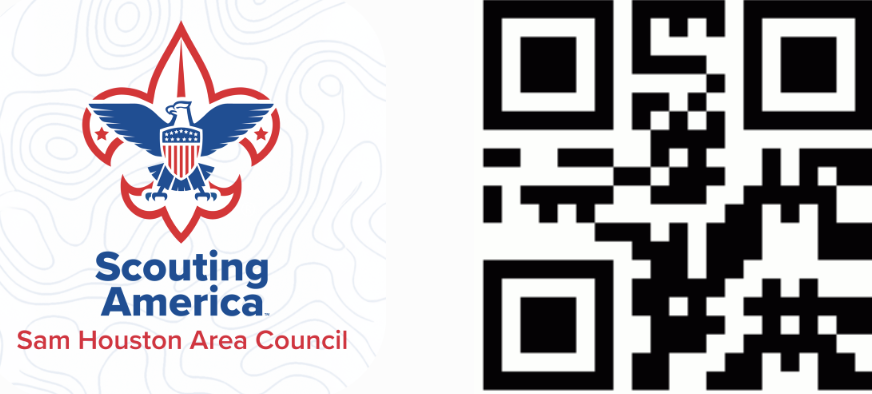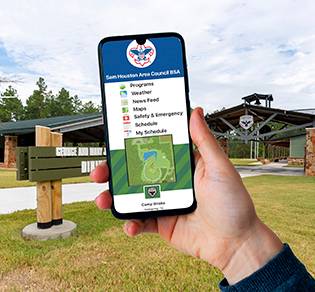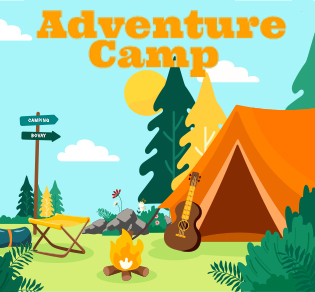Adventure Camp is weekend campout at Bovay Scout Ranch. Cub Scouts (kindergarten - 5th grade) and their families will enjoy an exciting variety of activities at several program areas. Meals are eaten in the air-conditioned dining hall.
Enjoy all the wonder and beauty of the central Texas rolling hills and lakes at Bovay Scout Ranch. Follow us on Facebook at facebook.com/BovayScoutRanch.
Youth Lead Program Stations
Adventure camp offers a unique leadership opportunity for youth staff, allowing them to lead program stations. These passionate young people will guide campers through activities, sharing their Scouting knowledge and enthusiasm.
Parents and adult leaders will provide hands-on support, assisting youth staff at activity rotations and helping to supervise and assist Cub Scouts. Your assistance not only supports older Scouts but also helps keep camp costs low.
Camp App
 Campsite assignments, the schedule, and the map are posted on the camp app the week of the event. During the event, emergency announcements are also sent through the app. Find the app by searching "Sam Houston Area Council" on both Apple and Android platforms.
Campsite assignments, the schedule, and the map are posted on the camp app the week of the event. During the event, emergency announcements are also sent through the app. Find the app by searching "Sam Houston Area Council" on both Apple and Android platforms.
Registration






 The pack leader should complete registration if attending with the pack. Families that register individually will be combined with families from other packs. Registration is on a first-come, first-served basis; sessions fill up fast.
The pack leader should complete registration if attending with the pack. Families that register individually will be combined with families from other packs. Registration is on a first-come, first-served basis; sessions fill up fast.
The registration fee is $50 per person and includes four meals (three on Saturday and breakfast on Sunday with vegetarian and turkey patty options), a patch, and program supplies. Children under five years of age attend free of charge; please note that the program is designed for Scouts. A $100 non-refundable deposit for the group secures a spot. All fees must be submitted at least 30 days before the camping date.
One adult per 15 Scouts in the pack may attend at no cost. This adult will be asked to volunteer as program staff and must attend the 8:00 am leader's meeting. To ensure your camp reservation, registration, including all fees, must be submitted at least thirty days prior.
Dates
|
Themes
|
Register
|
| February 27-March 1, 2026 |
Spring into Adventure |
Register |
| March 27-29, 2026 |
Spring into Adventure |
Register |
| April 10-12, 2026 |
Spring into Adventure |
Register |
| May 1-3, 2026 |
Spring into Adventure |
Register |
| May 15-17, 2026 |
Webelos Coyote Extreme |
Register |
| July 20-23, 2026 |
Webelos / Arrow of Light Quest |
Register |
| October 2-4, 2026 |
Trail or Treat |
Advanced Notification List |
| October 16-18, 2026 |
Trail or Treat |
Advanced Notification List |
| October 23-25, 2026 |
Trail or Treat |
Advanced Notification List |
| October 30 - November 1, 2026 |
Trail or Treat |
Advanced Notification List |
| November 21-23, 2026 |
Fall Adventure Camp |
Advanced Notification List |
| December 11-13, 2026 |
Winter Adventure Camp |
Advanced Notification List |
Sign up to be notified when registration opens for fall 2026. |
Volunteers
Part-time Volunteers: Our event is only successful with the help of volunteers. Each pack is to provide part-time volunteers. Let us know when registering who will be volunteering.
Full-time volunteers serving as a certified rangemaster or working in the dining hall for the entire day attend for free. This applies to those attending range master training on Friday evening and volunteering on Saturday.
Troops, crews, and ships that provide a half-day of service to the event can camp at Tellepsen Scout Ranch for free. Meals are included.
Volunteer Sign Up
Range Master Training
Archery, BB gun shooting, and slingshot shooting are restricted to district and council events where there are properly trained supervisors and where all standards for Scouting America range and target activities are enforced. A qualified range master must supervise all range and target activities in the Cub Scout program. Certified range masters are needed at district day camp and events, and also at council events.
Rangemaster training is being offered during most Adventure Camps. The classroom instruction is held on Friday night from 7:00 pm to Saturday at 10:00 am. The participants then complete their training by working on the range on Saturday.
Trainees who volunteer on the range the entire day may request a code for free Adventure Camp registration.
Register for Rangemaster training
What to Bring
|
Mark all items with Scout's name and troop number.
Do not bring valuables.
|
- Tent
- Sleeping bag, sheets or blanket
- Pillow
- Cot or air mattress
- Personal items (e.g., deodorant, comb, medications, toothpaste, toothbrush)
- Water bottle, canteen, or cup
- Scout uniform, determined by pack leadership
- Clothing appropriate for weather and extra clothes
- Closed-toed shoes (tennis shoes) and extra pair
- Pajamas or sleeping clothes
- Rain gear
- Flashlight and extra batteries
- Personal medications
- Swimsuit and towel (weather permitting)
- Towel and washcloth
- Sunscreen
- Pocket knife and Whittlin' Chip (3rd-5th graders)
- Personal first aid kit
- Day pack
- Hand sanitizer
|
Optional:
- Money for patches, snacks and beverages, and t-shirts at the camp trading post, Trader Vics.
- Alarm clock
- Battery-operated lantern
- Bicycle and bike helmet
- Book of Faith
- Camera
- Camp chair
- Cub Scout Handbook
- Fishing gear
- Glow sticks (great to keep track of your kids at night and to play games)
- Lockable footlocker
- Shower shoes
- Snacks (do not keep in the tent)
- Sports drinks or flavor packets for water (to help keep Scouts hydrated)
- Sunglasses
- Insect repellent
- Phone battery backup charger
- Wagon
|
Pack:
- Friday night snack, optional
- First-aid kit
Paperwork:
- Camp roster (emailed the Tuesday before camp - see instructions below)
- Copy of medical forms, two copies alphabetized in an envelope or notebook (one to keep in campsite and one to turn in during registration)
- Camper Release Form for Scouts whose parents are not attending camp
|
|
Mark all items with name and pack number. *Electricity is very limited.
About the Campsites. Campsites have a water spigot with potable drinking water, a covered pavilion with lights, one power plug, picnic tables, a flag pole, and a campfire ring. Campers can park in the parking lot next to the campsite. Shower houses are located between campsites with individual stalls that are ADA-compliant and have a toilet, shower, and sink.
What NOT to bring to camp: alcohol, valuables, electronics, firearms, guns/ammunition, illegal drugs, liquid fuel lanterns or stoves, pets, scooters, skates, skateboards
|
Camp App
 The camp app serves as a vital communication tool for all camp attendees, offering convenient access to essential resources such as the camp map, schedule, program updates, emergency announcements, and much more. You can find it by searching "Sam Houston Area Council" on both Apple and Android platforms.
The camp app serves as a vital communication tool for all camp attendees, offering convenient access to essential resources such as the camp map, schedule, program updates, emergency announcements, and much more. You can find it by searching "Sam Houston Area Council" on both Apple and Android platforms.

Program








Cub Scouts will explore the wonders of nature while participating in engaging activities designed to inspire environmental stewardship.
Trail to Treat program:
- BB & Archery
- Ghoul Games (team bonding with an entertaining twist)
- Creepy Contraptions (build a pumpkin demolition ball and float a pumpkin boat)
- Creative Bat Crafts (craft a flying bat, take on the Bat’s Blindfold Challenge, and make a Bat Snatcher toy)
- Crack the Cursed Water Crisis Conundrum
- Haunted Trail
- Jack-o-Lantern Contest
Tentative Schedule*
Friday
|
| 4:00 pm |
Camp opens.
Obtain specific campsite assignments upon arrival at the check-in building, located just past the entrance gate. |
Check-in Building |
| 4:00 - 9:00 pm |
Campers proceed to the assigned campsite and set up (eat dinner before arriving) |
Campsites |
| 6:00 - 7:00 pm |
One representative from each pack (or group registration) checks in (submits paperwork and picks up rotation schedule) |
Headquarters Building |
| TBD |
Movie on the lawn and a snack |
TBD |
| 8:30 pm |
Leader's meeting |
Headquarters Breezeway |
Saturday
|
| 7:30 - 9:00 am |
Late check-in at administration building |
Headquarters Building |
| 8:00 am |
Breakfast |
Dining Hall |
| 9:00 - 11:00 am |
Program activities |
Program Areas |
| 11:00 am |
Lunch |
Dining Hall |
| 1:00 - 4:00 pm |
Program activities |
Program Areas |
| 5:00 pm |
Dinner |
Dining Hall |
| 7:00 pm |
Free time with pack |
Campsites |
Sunday
|
| 8:00 am |
Breakfast |
Dining Hall |
| 9:00 am |
Check-out |
Headquarters Building |
| 11:00 am |
Camp closed |
|
*The final schedule will be provided during the leader's meeting on Friday night. Schedules vary based on camp attendance.
Leadership Requirements
Every registered unit must provide a minimum of two-deep leadership. "Two registered adult leaders 21 years of age or over are required at all Scouting activities, including all meetings. There must be a registered female adult leader 21 years of age or over in every unit serving females. A registered female adult leader 21 years of age or over must be present for any activity involving female youth or female adult program participants. Notwithstanding the minimum leader requirements, age and program-appropriate supervision must always be provided." (Source, Youth Protection and Barriers to Abuse FAQs). Each unit should have one BALOO-trained leader and one safe swim defense-trained leader. (Camp has waterfronts).
Adults:
Adults spending the night at camp must be either:
- Cub Scout parents or legal guardians taking part in an overnight Cub Scout program with their own child or legal ward are not required to register as leaders. All adults must review the "How to Protect your Children from Child Abuse: A Parent's Guide" that can be found in the front of each Cub Scout Handbook. In addition, the parent or legal guardian must be accompanied by a registered leader at any time they are with youth members other than their own child/ward. (Source)
- Currently registered in an adult fee-required position in the position(s) they serve. See FAQ for list of approved adult registration fee-required positions. (Source)
Tenting:
- Separate tenting arrangements must be provided for male and female adults as well as for male and female youth.
- Youth sharing tents must be no more than two years apart in age.
- In Cub Scouting, parents and guardians may share a tent with their family.
- Spouses may share tents. (Source)
The most recent updates to BSA's Guide to Safe Scouting policies must be followed and all Scouting activities be conducted in a safe and prudent manner including using the Age-Appropriate Guidelines for Scouting Activities .
Arrival and Check-in
Campers may arrive beginning at 4:00 pm on Friday. Upon arrival, all campers will stop at the check-in building inside the main gate and be provided a parking pass and campsite assignment. Campers can go to their campsite and set up camp. Upon arrival at the campsite, please inspect the campsite to ensure there are no safety issues or prior damages. If there are any issues, report them to the staff immediately. All campsites have a pavilion with multiple picnic tables and a red fire water bucket.
All persons on site will be provided a wristband and must always wear their designated wristbands. Wristband colors determine which rotation schedule that is to be followed. The rotation schedule is designed for a specific number of youth at each outpost.
One representative from each pack or group must check in between 6:00 - 7:00 pm at the Headquarters Building (approximately one mile past the main gate on the left) and register the unit or group. To facilitate a quicker registration process, please be sure to have all of the medical forms.
Medical Forms
All Adventure Camp participants must have a completed BSA Annual Health and Medical Record (Part A, B1, B2 for all Scouting events) .
Bring two copies alphabetized in an envelope or notebook (one to keep in campsite and one to turn in during registration).
The following are the most common errors or omissions made on the BSA Annual Health and Medical Record submitted:
Leader's Meeting
There is a mandatory leader's meeting at 8:30 pm in the Safari Room located in the Administration Building.
Departure Procedures
Departure is after breakfast on Sunday between 9:00 am - 11:00 am. The camp quartermaster will drop off cleaning supplies at the restrooms on Sunday morning. Follow the written instructions for cleaning assigned showers and restrooms. Scouts should conduct a police line where Scouts stand within arm's length of each other and walk the entire campsite picking up all trash. The camp quartermaster and camp staff will inspect each campsite to make sure the campsite, restrooms, showers, and pavilions are undamaged and clean, and that all gear and trash is removed. The trash is to be taken and dropped off at the dumpsters near the front of the camp on the way out. Dumpster at the dining hall is for kitchen use only. After passing inspection, the designated leader should proceed to the administration building to sign out and pick up paperwork.